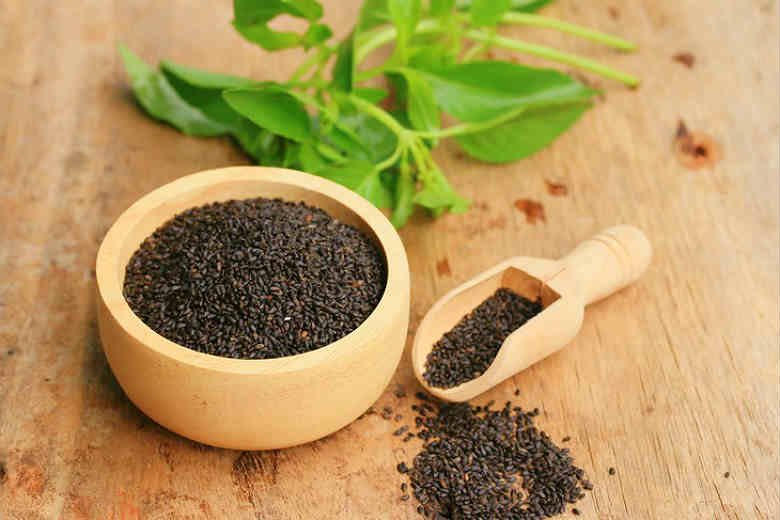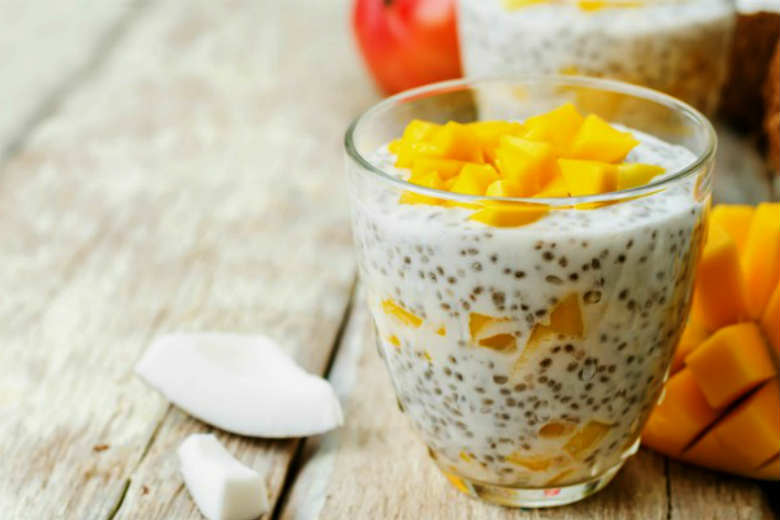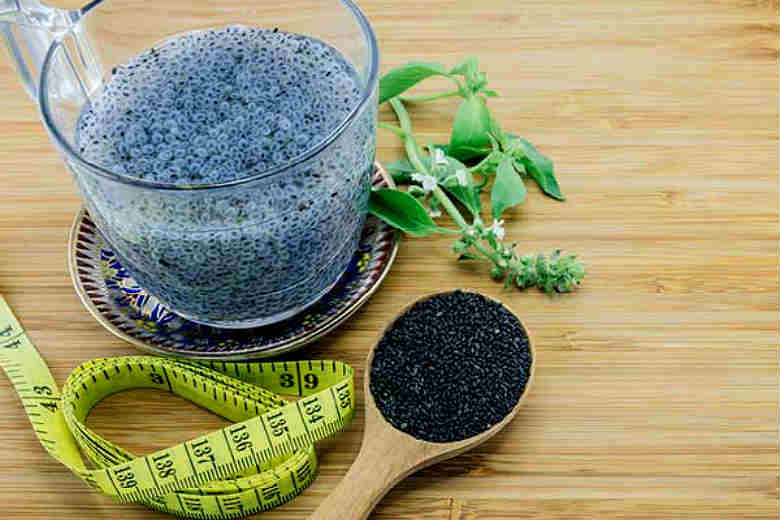Have you ever tried sabja seeds to improve the condition of your skin, hair, and overall health? Do you know these holy seeds can make your weight loss goal much easier? Making sabja seeds a part of the daily diet is the newest health trend everyone is going ga-ga over. If you are not very into chemical-based practices for your health and beauty, you should join the bandwagon, too. This superfood has been delivering impressive benefits for ages, and you should know about it to naturally look and feel healthy and beautiful. So, let us talk about the fantastic health, skin, hair, and weight loss benefits of sabja seeds in this article. We will also focus on its uses and potential side effects.
What Are Sabja Seeds?
Sabja seeds or basil seeds (tukmaria / tukmalanga / sub/splash / falooda) are tiny black, fragrant seeds that resemble chia seeds in size and color. They are obtained from the sweet basil plant (scientifically called Ocimum Basilicum), which is native to Southeast Asia. As one of the most beneficial herbs, sabja has long been used in Ayurvedic and Chinese medicine. The tear-shaped seeds have a rich concentration of powerful antioxidants and other active ingredients, which impact human health and beauty to a great extent. They are also considered popular additions to various Asian and global dishes. Though the magical seeds have a mild taste and a bland flavor, they add a light crunch to the food and give it a significant nutritional boost (1).
Sabja seeds are obtained from the sweet basil plant, which is typically used for consumption. It is different from the holy basil plant or ‘tulsi'(Ocimum Tenuiflorum).
Nutritional Value Of Sabja Seeds
Sabja seeds come loaded with nutrition, which keeps us healthy from the inside and beautiful from the outside. They possess 42% carbohydrates, 20% proteins, and 25% fats. The vitamin and mineral contents of the seeds are also exceptionally high. They contain calcium (244% of RDI or recommended daily intake), magnesium (178% of RDI), iron (499% of RDI), potassium (56% of RDI), folic acid (78% of RDI), vitamin E (53% of RDI), and vitamin K (185% of RDI). Sabja seeds also hold large amounts of dietary fibers, phytochemicals, polyphenolic flavonoids, omega-3 fatty acids, alpha-linolenic acid (ALA), lutein, orientin, vimentin, and almost negligible calories.
Read Also – 18 Incredible Benefits Of Sunflower Seeds For Skin, Hair And Health
Benefits Of Sabja Seeds For Health
1. Packed With Nutrition
Fresh sabja seeds are loaded with all those essential nutrients required for the plant’s germination. Adding these seeds to your regular diet can help you get sufficient carbohydrates, proteins, fats, sugar, dietary fibers, vitamins, minerals, and calories. Hence, your bodily functions are regularized, and you can avoid several ailments.
2. Helps In Digestion
Scientists have proved that sabja seeds have excellent carminative effects. It contains a very high level of insoluble dietary fibers. They serve the purpose of a natural detoxifying agent, which cleanses out our entire gastrointestinal tract efficiently. As the stomach becomes toxin-free, digestion becomes more accessible, and the scope of developing digestive issues like upset stomach, cramps, indigestion, flatulence, etc., also decreases.
Read Also – Ways To Get Rid Of Hair Loss With Fenugreek Seeds
3. Cures Constipation
Being rich in insoluble dietary fibers, sabja seeds can reduce constipation to a great extent or even cure it completely. The mucilaginous gel around their inner covering also turns the ingredient into an emollient upon soaking and significantly contributes to its laxative effect. All you need to do is soak a handful of the seeds in a glass of milk and drink it every night before bed. It will make bowel movements through your intestines smoother, thereby relieving constipation.
4. Heals Acidity Or Stomach Burn
Sabja seeds are very soothing for our gastrointestinal tract, especially the stomach. If you feel an acute burning sensation in your abdomen, you should consume sabja seeds the previous way, i.e., infusing them in milk. Practicing it for a few weeks will provide a calming and comforting effect on your digestive system, thereby healing acidity or stomach burn.
Read Also – Top 10 Health Benefits Of Papaya Seeds
5. Treats Type-2 Diabetes
People who have type-2 diabetes can benefit from sabja seeds in their diet. They are known to control the amount of sugar in our bloodstream, which eventually stabilizes the blood sugar levels and treats diabetes efficiently.
6. Relieves Respiratory Issues
As per a new study, sabja seeds are beneficial in reducing various respiratory issues. Take one tablespoon of pure raw honey, one tablespoon of finely grated ginger, and one tablespoon of fresh sabja seeds in a glass of water. Please bring it to a boil and drink the infusion for two weeks. You will eliminate colds, coughs, influenza, bronchial asthma, etc.
7. Diminishes Stress
Sabja seeds are one of the best natural stress busters. As said before, they have lovely calming effects on our bodies, similar to aromatherapy. Therefore, incorporating these seeds into your daily food reduces stress levels, increases mental clarity, improves mental strength, and uplifts mood.
8. Regulates Body Heat
Regarding keeping our bodies cool during those scorching summer days, sabja seeds can be a true rescuer. It has excellent cooling properties and can bring down body heat instantly. Hence, it is used as an adequate body coolant. Just submerge a handful of fresh sabja seeds in a glass of water for a few hours and drink it directly or with milk. They become even twice more effective when taken with rose petal water or jam (Gulkand).
Read Also – How To Use Kalonji Seeds For Weight Loss?
Benefits Of Sabja Seeds For Weight Loss
According to health experts, sabja seeds can help reduce excess body fat if included in a weight loss diet. When soaked in water, sabja seeds expand as much as 30 times their actual volume or size. It makes the texture of the seeds gelatinous and turns the drink into a filling one (with the most minor calorie consumption). In short, the high fiber content of these seeds can keep us full for a longer time and curb our appetite dramatically.
Benefits Of Sabja Seeds For Skin
Healthy skin is nothing but a reflection of good health. So, let’s take a peek into the skin benefits offered by such incredibly healthful sabja seeds:
1. Keeps Breakouts Away
Being a natural detox, sabja seeds can cleanse your internal system and keep several skin issues like acne, pimples, blackheads, whiteheads, etc., away.
2. Heals Skin Infections
They hold anti-microbial, anti-fungal, and antibiotic qualities, which can keep our skin healthy and infection-free.
3. Gives Flawless Skin
Regular intake of sabja seeds can enrich our skin cells with essential vitamins and minerals. As a result, we get a blemish-free, radiant skin naturally.
4. Prevents Premature Aging
You can prepare an anti-aging face pack for your skin by grinding dry sabja seeds into a fine powder and blending it with a tablespoon of coconut oil.
Read Also – Using Pumpkin Seeds For Hair Loss & Skin Care
Benefits Of Sabja Seeds For Hair
It has also been proved that sabja seeds benefit our hair. Protein is the main component of our hair, and sabja seeds can provide a considerable amount of this nutrient to our body. As a result, you experience less hair fall, better hair growth, and excellent hair volume. You can also ward off pesky dandruff with DIY sabja seed hair oil. Combine olive or coconut oil with sabja seed powder, massage your scalp with the concoction, and leave overnight.
Side Effects Of Sabja Seeds
Sabja seeds have been reported to be entirely safe for moderate consumption and well-tolerated by people. But though sabja seeds deliver many benefits for our health and appearance, they come with risks. Possible side effects of excessive consumption of sabja seeds include nausea, vomiting, upset stomach, bloating, diarrhea, acid reflux, loss of appetite, headache, acne, thyroid imbalance, choking hazards, etc. They influence the level of estrogen hormone in the body, which can stimulate menstruation and create severe complications for pregnant and lactating women. Hence, they should consult a specialist before including sabja seeds in their diet. They also contain vitamin K, which may interfere with blood-thinning drugs like warfarin.
How To Prepare Sabja Seed Water?
Sabja seeds are most commonly used to prepare a water infusion. Giving yourself a nutrient-rich burst with those seeds is the simplest way. Add one teaspoon of sabja seeds to a cup of warm water and let them soak for around 15 minutes. As the seeds swell up and become soft, you can see a gelatin-like translucent, grey-colored film surrounding each seed while the center remains black. The size of each seed also becomes three times its original volume. Ensure you always maintain the 1:1 ratio, as too little water can create a lump of seeds. You can certainly use plain water for pre-soaking, but warm water makes the seeds swell up completely and allows them to release most of their vital nutrients, antioxidants, and digestive enzymes. This makes the sabja seed water infusion the healthiest and the most nutritious drink ever. However, you can strain the soaked seeds and use them in several other ways.
Soaking sabja seeds for at least a couple hours before the use ensures that their digestive enzymes are released fully. They can be used either with their jelly-like coat or without it after rinsing and straining thoroughly.
Other Ways To Use Sabja Seeds
Apart from the essential sabja seed water, there are plenty of other ways to use these nutrition-packed seeds. You can:
- Blend them into lemonade and other refreshing drinks for added freshness.
- Sprinkle them over fruit juices, smoothies, milkshakes, beverages, and desserts.
- Add them to your favorite soups, stews, pancakes, and pasta dishes for a ‘crunch.’
- Combine them with fruits, yogurt, pudding, vegan cheeses, and cream sauces.
- Please include them in your bowls of hot cereals like oatmeal.
- Grind them dry and mix with all-purpose flour to prepare bread and muffins.
- Replace eggs with whole, soaked sabja seeds in baked goodies.
- Use them as a ‘grassy’ topping or dressing for salads.
- Munch on them as a low-calorie snack.
The thickening properties of sabja seeds and chia seeds are similar as both of them create a thick, gelatinous mixture upon soaking in water. But sabja seeds soak up water in just 5 imnutes while chia seeds take up almost an hour to soften. So, sabja seeds are used as an alternative to chia seeds.
Also Read – Excellent Benefits of Chia Seeds for Hair, How to Use, and Daily Dosage
Tips To Use Sabja Seeds Safely
1. Follow The Liquid-Seed Ratio
When soaked in water, sabja seeds can form a sizeable gelatinous clump. This poses a choking hazard, especially in people with swallowing difficulties. Therefore, older adults or young children need to know how to safely and effectively consume these healthful seeds. All you need to do is follow the proper ratio of liquid to seeds to prevent the seeds from turning gelatinous and getting clumped together. If the mixture remains liquid, it will no longer be challenging to swallow.
2. Start Slowly, Build Gradually
Do not start consuming many sabja seeds right from the very first time. It will be hard for your gut to adjust as they are rich in dietary fibers. Instead, start with a minimal amount and increase your intake gradually. It will allow your stomach to adjust to the fibers and keep your health intact.
Frequently Asked Questions (FAQs)
Where To Find Sabja Seeds?
Edible sabja seeds are readily available online or offline in Asian food stores. If you have a sweet basil plant at home, you can also collect pure and organic sabja seeds.
Can I Eat Sabja Seeds Daily?
Considering its benefits, you can eat sabja seeds every day. However, you must consult your doctor before including it in your daily regime to avoid adverse effects.
When Should I Drink Sabja Seed Water?
Consume sabja seed water at least half an hour before having your meal. This will help you enjoy the optimal health benefits and weight loss benefits.
Can I Chew Or Swallow Sabja Seeds?
You can, but experts do not recommend it. Instead, soak them before consuming them so that the nutrients and enzymes are released fully.
Also Read – Health, Skin, and Hair Benefits of Fenugreek Seeds You Need to Know
References:
- “10 Amazing Basil Seeds Health Benefits & Uses“, OrganicFacts.net



